sleep and circadian rhythms
1/42
There's no tags or description
Looks like no tags are added yet.
Name | Mastery | Learn | Test | Matching | Spaced |
|---|
No study sessions yet.
43 Terms
definition of sleep
it is a natural, periodic state that involves reduced responses to environmental stimuli and decreased mobility
it differs from states such as coma (extended period of unconsciousness), vegetative state or brain death (no sign of brain activity and no response to stimuli)

what are the processes the control sleep?
homeostatic (s) - if we do not sleep we accumulate sleep debt
circadian (C) - sleep tends to happen at a particular time during the 24-hour cycle
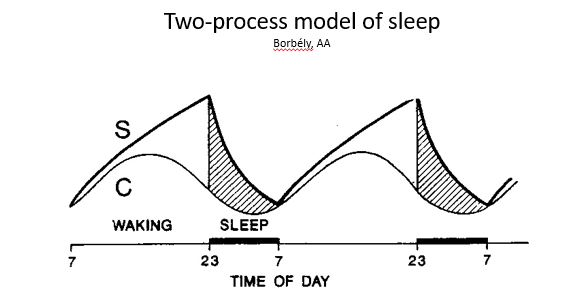
aspects of sleep research
involves recordings of electrical activity from multiple sources (polysomnography)
discovered by Hans Berger (1929)
used initially in cats but now used for research and clinical purposes
recordings revealed a specific sleep architecture
aspects of polysomnography
EEG recordings (electroencephalogram): recordings of activity of populations of neurons in the brain underneath the skull
EOG recordings (electrooculogram): recordings of activity of the muscles around the eyes to decipher eye movements
EMG recordings (electromyogram): recordings of the activity of the muscles in the body
These recordings can be combined with others such as heart rate, temperature, breathing (O2) etc
what is brain activity like during wakefulness?
different types of neuronal activity are observed in the EEG recording
beta waves consist of irregular activity of 13-30Hz
alpha waves consist of activity of 8-12Hz

what is brain activity like during sleep?
sleep begins with a state of relation/feeling drowsy
stage 1 (3.5-7.5Hz) - presence of theta activity (it is a transition between sleep and wakefulness)
stage 2 - sleep begins and it characterised by irregular activity and also sleep spindles (12-14Hz) although these occur in other stages of sleep and K complexes which are only found in stage 2
stage 3 - high-amplitude and low-frequency delta activity (less than 3.5Hz)
Synchronized, regular waves, reflecting synchrony and coordination in the activity of neurons in underlying brain areas
There is a slowing down of brain activity as well as other bodily functions, such as heart rate, breathing, temperature, kidney function, etc
Sometimes referred to as slow-wave sleep (SWS), or deep sleep

describe REM sleep
characterised by increased brain activity and asynchrony in brain waves accompanied by muscle atonia
Aserinsky and Kleitman (1953) - sleep characterised by rapid eye movements (REM)
Michel Juvet (1959) - deep sleep in terms of muscle activity but light sleep in terms of brain activity (paradoxical sleep)
facial twitches, erections, vaginal secretions, dreaming occurs during thos stage
patterns of activity during sleep
Sleep recordings revealed four distinct patterns of activity, three stages of sleep (NREM), 1, 2, 3 and an additional REM sleep episode
We cycle through each stage and back, with each cycle lasting approximately 90 minutes
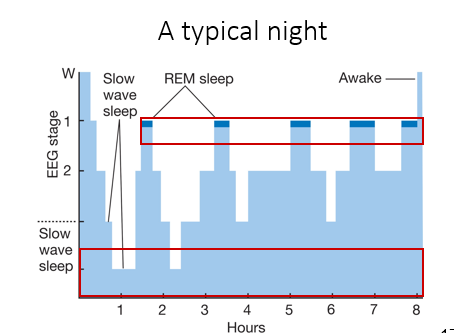
key aspects of dreams
discovered by Dement and Kleitman (1957) when participants awakened from REM sleep - tended to report vivid dreams
considered important in psychoanalysis (Freud, Jung - unconscious)
most are related to events that happen in a person’s life
Calvin Hall et al (1982) - analysed 10,000 dreams of healthy people and found that more than 64% are associated with sadness, anxiety or anger whereas 18% are happy dreams and only 1% involved sexual content
describe J. Allan Hobson (2004) – Activation-synthesis hypothesis (bottom-up view on dreams; contemporary views on dreaming)
The brainstem is activated during REM and sends signals to the cortex which creates images with actions and emotions from memory
The frontal cortex is less activated during dreaming so there is no logic in the timing or the sequence of events, although the person tries to organize the content into a logical story when awake
There is no meaning in dreaming although dreams are based on each person’s experiences
describe Valli and Revonsuo (2009) - Coping Hypothesis (also known as Clinico-Anatomical Hypothesis) (top-down view on dreams)
argued that dreams are biologically adaptive and they lead to enhanced coping strategies
People dream about events that they find threatening in their lives
Support for this hypothesis is the evidence that problem solving occurs during sleep (“sleep on it”)
the neural basis of sleep
idea of a sleep-inducing substance perhaps due to the fact that many natural substances cause sleep i.e. morphine
neuro chemicals and hormones produce sleep-wake cycles
melatonin secreted by the pineal gland during the dark promotes sleepiness but it is not the only one
role of adenosine
accumulates during the day after prolonged wakefulness and promotes sleep
caffeine antagonises the effects of adenosine and decreases sleepiness
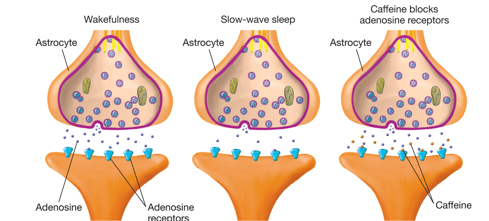
observations and discovery
Constantine von Economo - early 20th century observed patients with encephalitis
observed damage in an area of the anterior hypothalamus
this area was later identified as the ventro-lateral preoptic area which contains inhibitory neurotransmitters such as GABA

brain areas involved in wakefulness and arousal
the reticular formation (Reticular Activating System - RAS) is comprised of several nuclei in the brainstem that extend to the forebrain to promote arousal
Locus coeruleus (LC - NE/NA)
Raphé nucleus (RN – 5HT)
Tuberomammillary nucleus (TMN-Histamine) * antihistamines
Nucleus basalis of Maynert (NBM-Ach) * also high during REM sleep

key components of the ascending arousal system
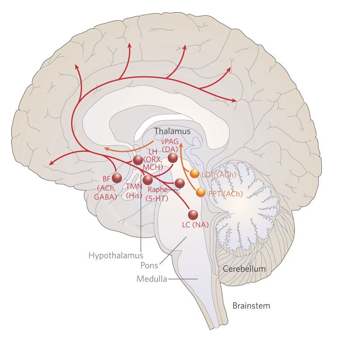
key projections from the vLPOA to areas of the ascending arousal system

the flip-flop switch (Cliff Saper, 2001)
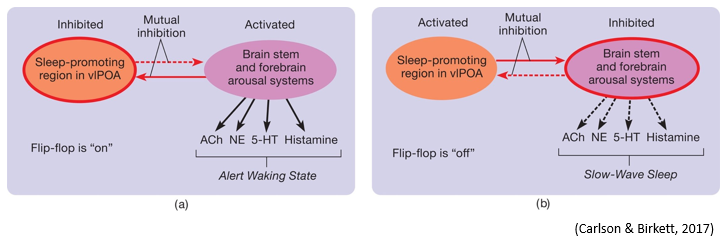
orexin or hypocretin(??)
it is a peptide released from the lateral hypothalamus (LH)
highly responsible for the maintenance of wakefulness
implicated in narcolepsy
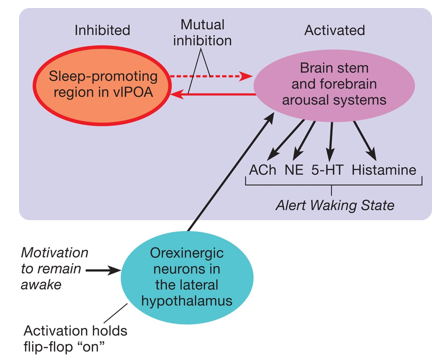
circadian rhythms
rhythms or regular patterns of activity associated with a 24h-cycle such as day and night
endogenous cycles (“generated from within”); the brain and body spontaneously generate their own rhythms based on the earth’s rotation
endogenous rhythms can also be annual (migration) or seasonal (breeding)
humans are diurnal (vs nocturnal)
this 24h rhythm not only controls sleep and wakefulness but also other important functions such as body temperature, secretion of hormones, urination, etc

early discoveries about circadian rhythms (non-human)
Biorhythms are not unique to humans and animals - flowers may open during the day and close during the night
1729: French geologist, Jean Jacque d’Ortous de Mairan experimented with the mimosa plant - even if isolated from light, dark or temperature cues the leaves continued their rhythmic behaviour
early discoveries about circadian rhythms (human)
Aschoff (1965)
Humans were placed in an underground bunker where no external cues
Allowed to select their light-dark cycle and turn the lights on and off at will
The participants continued to show daily sleep-activity rhythms, even though they drifted to >24hrs
Concluded that humans have an endogenous biological clock which governs sleep-wake behaviour
setting and resetting the biological clock (entrainment)
External cues that serve to set our biological clock are called Zeitgebers (“time givers”)
The most potent zeitgeber for humans is light although there are others (meals, activity, temperature, etc)
When a zeitgeber resets a biorhythm, that rhythm is said to be entrained.
what is jet lag?
a disruption of the circadian rhythms due to crossing time zones
stems from a mismatch of the internal circadian clock and external time
sleepiness during the day; sleeplessness at night and impaired concentration
travelling west “phase-delays” our circadian rhythm whereas travelling east “phase-advances” our circadian rhythms (people find it more difficult)
variability in our circadian rhythms
may differ between people and can lead to different patterns of wakefulness and alertness - chrono types
morning people (“larks”); evening people (“owls”)
rhythms have a genetic basis but they also change as a function of age and other external factors
chronotypes across the lifespan
We all start off (infancy and childhood) and finish off (adulthood and old age) as morning people “larks”
•During adolescence there is an increasing shift towards “eveningness” – teenagers become “owls”, which is particularly difficult given that school starts early in the morning
differences in chronotype may result in “social jet lag”
morning people report to be happier than evening people
suspecting the existence of the biological clock
Ritchter (1927) - introduced the concept that the brain generates its own rhythms so it must have a biological clock
he attempted to locate it in the brains of rats; he performed lesions in various parts of their brain in order to locate the biological clock
the rats lost their rhythmic behaviour after damage to the hypothalamus
he hypothesised that many disorders may result form disruption of the biological clock
what is the biological clock?
discovered by Moore & Eichler and Stephan & Zucker (1972)
located in the suprachiasmatic nucleus (SCN)
lesions of this nucleus disrupted circadian rhythms of wheel-running, drinking, and hormonal secretion so was named “the master clock”
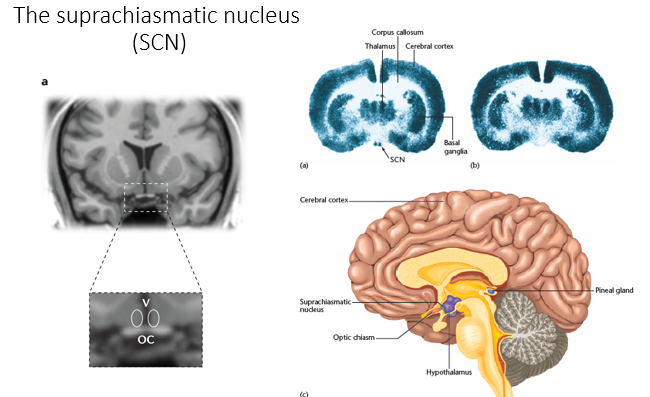
the suprachiasmatic nucleus
recording electrodes in the SCN confirm that neurons are more active during the light period than the dark period
a single cell extracted from the SCN and raised in tissue culture continues to function in rhythmic pattern
transplantation of an SCN into a donor organism results in the recipient following the donor’s rhythm
how does light reach the SCN?
the SCN receives info about light through the retinohypothalamic tract, formed by a special population of ganglion cells (photosensitive retinal ganglion cells - PRCGs) which make up approx. 1-3% of ganglion cells

the retinohypothalamic tract
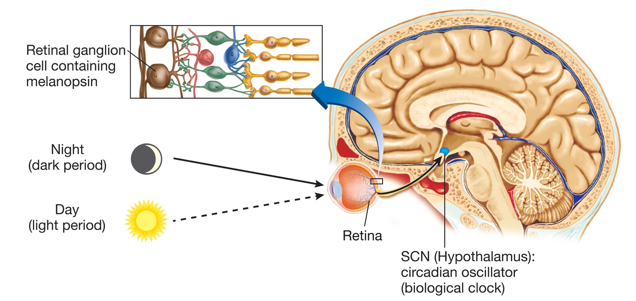
how does the biological clock work?
Jeffrey Hall & Michael Rosbash - studied the SCN in Drosophila (fruit flies)
1984: Discovered the “per” gene and the “PER” protein (period)
Michael Young,1994: Discovered the gene “tim” that produces the “TIM” protein (timeless)
When TIM meets PER they combine and shut the period gene down
the molecular mechanism
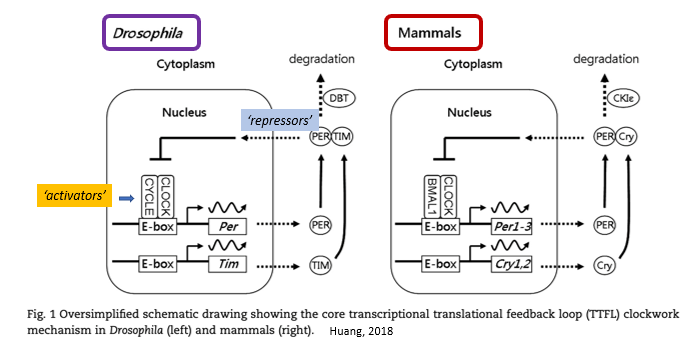
transcription-translation-inhibition (feedback loop)
A few genes and their protein products are involved in this clock
Transcription from DNA to mRNA, to translation into proteins which form dimers
These dimers enter the nucleus in order to inhibit transcription and then they decay
The cycle begins again in a daily rhythm

SCN effects on the pituitary gland and the pineal gland
the SCN regulates waking and sleeping by controlling activity levels in other areas and secretary glands such as the pituitary and the pineal glands

other effects of the SCN
breeding of animals is controlled by the SCN via the pineal gland
the time of da affects performance in humans on a wide range of cognitive tasks measuring attention, executive functioning and memory
treatment of disease can be influenced by circadian rhythms
the SCN drives a number of slave oscillators, each responsible for the timing of a different type of behaviour
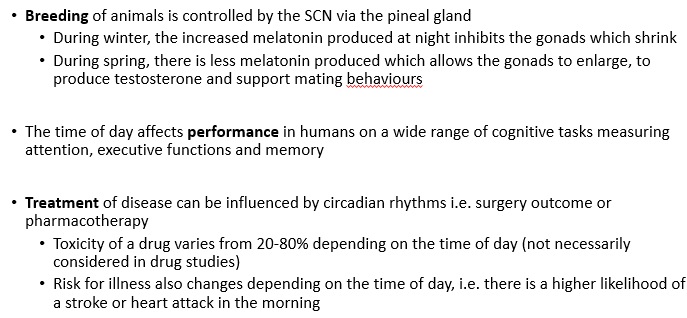
sleep deprivation in rats
Rechtschaffen et al 1983: the animals looked sick, they stopped grooming, became weak and lost their ability to thermoregulate.
they were losing weight although they were eating more and eventually, they died
in human studies there are restrictions due to ethical reasons but sleep deprivation is associated with increases in body weight
what are the reasons for why do we sleep?
adaptive
restorative
developmental
cognitive processes
sleep is adaptive
The original function of sleep was probably to conserve energy
Decrease in body temperature of about 1-2 degrees Celsius in mammals
Decrease in muscle activity
Increase in sleep time when there is scarcity of food
Normally our brain spends ~20% of our energy even though it is very small (2%) compared to our body weight
This is true especially for NREM sleep, particularly SWS where metabolic rate and blood flow to the brain decrease, but not for REM sleep
sleep is restorative
Sleep takes place at night, at the end of a busy day and helps us to feel refreshed and energized the next day
Activity during wakefulness results in the accumulation of free radicals (oxidative stress) and potentially toxic waste (such as amyloid beta).
During sleep, restorative mechanisms take place to remove the free radicals and toxic waste
sleep promotes development
The first clue that perhaps sleep has a role in brain development comes from the fact that infants sleep a lot more than adults
REM sleep in adults accounts for about 20-25% of total sleep whereas in infants it takes up about 50% of total sleep time
During stage 3 sleep (SWS), Growth Hormone (GH) release is at its peak which is important for growth
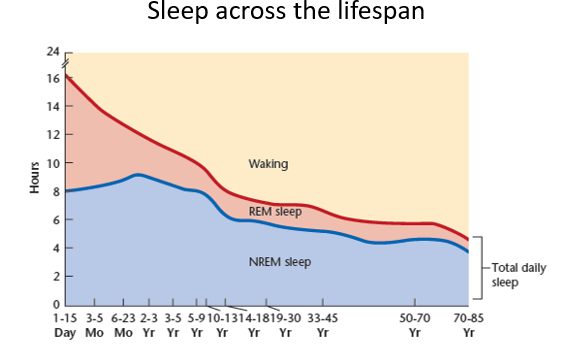
sleep facilitates cognition
sleep enhances learning and memory
problem-solving and creativity
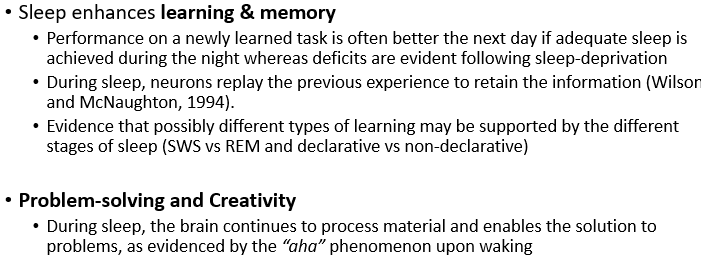
consolidation and systems consolidation
Müller and Pilzecker 1900: consolidation helps to establish memories in our brains for future use
It involves the synthesis of new proteins and the formation of new synapses
The memory traces themselves are not stored in the hippocampus forever. Instead, they are transferred to areas of the cortex, known as systems consolidation
Memory traces that are thought to be unnecessary are removed Synaptic homeostasis hypothesis (Tononi & Cirelli 2014)
synaptic pruning during sleep helps to reinstate the brain so that it can be able to function and learn more the next day